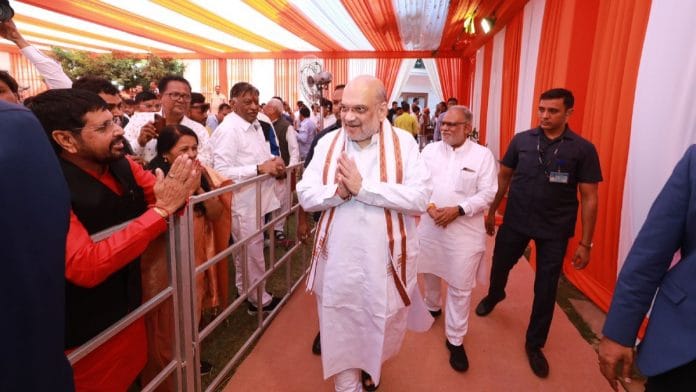New Delhi: The Bharatiya Janata Party (BJP) is hoping to gain from the Aam Aadmi Party’s (AAP’s) push in Gujarat’s Saurashtra region, especially in seats that the ruling party lost to the Congress by narrow margins in 2017. But AAP should not be allowed “to gain too much ground” and its vote share should be minimised, BJP chief strategist Amit Shah is learnt to have told party leaders during his visit to Saurashtra earlier this week.
As a fallout of the Patidar agitation, BJP’s tally in 2017 reduced to 23 of 54 seats in the Patel-dominated Saurashtra-Kutch region, where it had won 35 seats in the 2012 assembly polls. The party is now relying on AAP for the advantage it needs to win triangular contests in the region.
Moreover, just like in Himachal Pradesh, the BJP has initiated an exercise to evaluate the performance of its sitting MLAs in Gujarat while collecting feedback from the cadres.
For this purpose, the party divided the state into four zones — south, central, north and Saurashtra — and appointed observers in each zone to interact with local party functionaries and various other stakeholders between 27 and 29 October.
Also Read: Not just Modi, Gujarat BJP’s banking on CR Paatil’s ‘82-lakh army’ to micromanage state polls
‘Don’t be overconfident’
Earlier this week, Amit Shah conducted marathon meetings with party leaders in Saurashtra to chalk out a strategy for the upcoming assembly polls.
He emphasised that the BJP should take both the Congress and AAP seriously as political opponents, said party functionaries privy to the deliberations. “Party leaders and workers were told to work hard and not be overconfident. We have been given a target of 150 seats and a triangular contest in some seats, especially in the Saurashtra region, will be beneficial to the party, Amit ji said in the meeting,” a senior state BJP leader told ThePrint, not wanting to be named.
Shah, it is learnt, also said that the BJP must have a different strategy in place for each seat.
But the party is confident that in key seats it lost in 2017, the AAP may end up being a vote-cutter. “There are many seats where we lost out due to 1,000-2,000 votes and in those seats, Congress had emerged stronger. The party had to rely on some independent candidates to cut into Congress’s vote but that work will be done by AAP now. Damage to the Congress would be much more than to the BJP,” said the leader quoted above.
For instance, the Congress’s margin of victory over the BJP in 2017 was paper-thin in two tribal-dominated reserved seats, Dangs (768 votes) and Kaprada (170 votes).
“The Congress had emerged strong in rural areas, especially in the Saurashtra region. We can see that AAP is visible in this region and they have even tried to poach our leaders. The AAP is trying to hurt our prospects by making it a triangular contest in this particular belt and the tribal belt,” a senior state Congress leader told ThePrint.
Indranil Rajguru, a prominent Gujarat Congress leader from Saurashtra, joined Arvind Kejriwal’s AAP in April this year. The BJP, meanwhile, inducted former state Congress chief Hardik Patel, who led the agitation for Patidar reservation, in June.
‘BJP could field 20-25% new faces’
The BJP, which has been in power in Gujarat since 1995, is trying to improve its 2017 tally, when the Congress won 77 seats and confined the ruling party to 99. The BJP’s target, this time around, is to win 150 seats in the 182-member legislature.
According to sources in Gujarat BJP, the party is likely to give a chance to 20-25 per cent of new faces. “The party will focus on winnability instead of the ‘no-repeat’ mantra for the assembly elections. If the candidate is likely to win, then the no-repeat theory will not come in the way of her/his ticket. It is expected that now only 45-50 new faces will be fielded,” said another Gujarat BJP leader.
A third BJP leader said the AAP will be able to garner some gains in several seats in the Saurashtra region by targeting specific communities, adding that it could help the BJP if it results in a three-way split. The AAP, he added, has been eyeing the rural and tribal belt, especially where Congress enjoyed greater support in 2017 and BJP is still struggling, notably over issues related to the upkeep of cow shelters.
In April, the AAP cited its internal survey to claim that it is winning 58 seats in Gujarat. Sandeep Pathak, the party’s state in-charge for Gujarat, also said that AAP is likely to get the votes of lower and middle-class segments in urban areas and rural voters who are upset with the Congress.
(Edited by Amrtansh Arora)
Also Read: Garbage-sewage politics at heart of Delhi MCD poll campaigns as AAP-BJP blamegame continues






